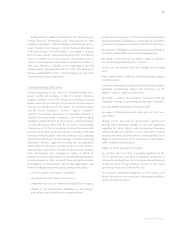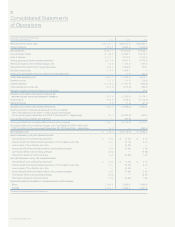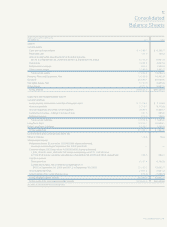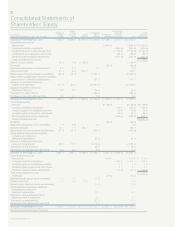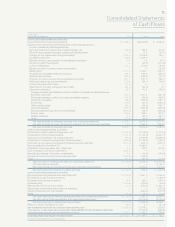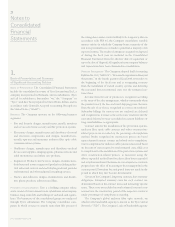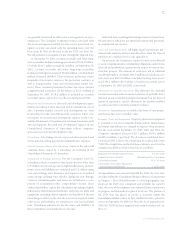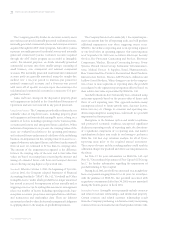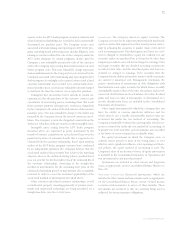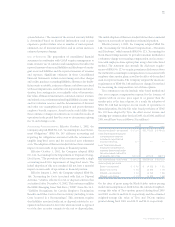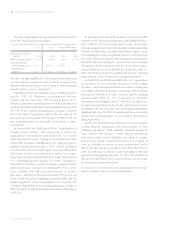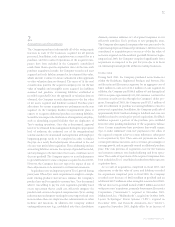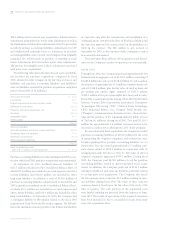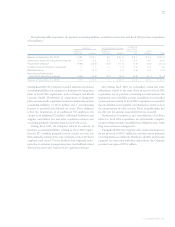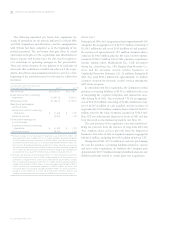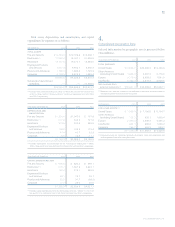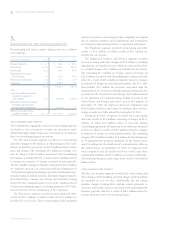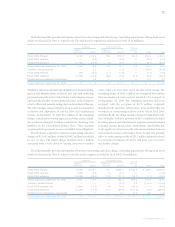ADT 2003 Annual Report Download - page 77
Download and view the complete annual report
Please find page 77 of the 2003 ADT annual report below. You can navigate through the pages in the report by either clicking on the pages listed below, or by using the keyword search tool below to find specific information within the annual report.
75
system batteries.) The amount of the accrued warranty liability
is determined based on historical information such as past
experience, product failure rates or number of units repaired,
estimated cost of material and labor, and in certain instances
estimated property damage.
Use of Estimates The preparation of consolidated financial
statements in conformity with GAAP requires management to
make extensive use of estimates and assumptions that affect the
reported amount of assets and liabilities and disclosure of contin-
gent assets and liabilities and the reported amounts of revenues
and expenses. Significant estimates in these Consolidated
Financial Statements include restructuring and other charges
and credits, purchase accounting liabilities, allowances for doubt-
ful accounts receivable, estimates of future cash flows associated
with asset impairments, useful lives for depreciation and amor-
tization, loss contingencies, net realizable value of inventories,
fair values of financial instruments, estimated contract revenues
and related costs, environmental and legal liabilities, income taxes
and tax valuation reserves, and the determination of discount
and other rate assumptions for pension and post-retirement
employee benefit expenses. Actual results could differ from
these estimates. Changes in estimates are recorded in results of
operations in the period that the event or circumstances giving
rise to such changes occur.
Accounting Pronouncements Effective October 1, 2002, the
Company adopted SFAS No. 143, “Accounting for Asset Retire-
ment Obligations.” SFAS No. 143 addresses accounting and
reporting for obligations associated with the retirement of
tangible long-lived assets and the associated asset retirement
costs. The adoption of this new standard did not have a material
impact on our results of operations or financial position.
Effective October 1, 2002, the Company adopted SFAS
No. 144, “Accounting for the Impairment or Disposal of Long-
Lived Assets.” The provisions of this statement provide a single
accounting model for impairment of long-lived assets. The
initial adoption of this new standard did not have a material
impact on our results of operations or financial position.
Effective January 1, 2003, the Company adopted SFAS No.
146, “Accounting for Costs Associated with Exit or Disposal
Activities,” which is effective for exit or disposal activities that
are initiated after December 31, 2002. This statement nullifies
the FASB’s Emerging Issues Task Force (“EITF”) Issue No. 94-3,
“Liability Recognition for Certain Employee Termination
Benefits and Other Costs to Exit an Activity (including Certain
Costs Incurred in a Restructuring).” This statement requires
that liabilities associated with exit or disposal activities be rec-
ognized and measured at fair value when incurred as opposed
to at the date an entity commits to the exit or disposal plans.
The initial adoption of this new standard did not have a material
impact on our results of operations or financial position.
Effective January 1, 2003, the Company adopted SFAS No.
148, “Accounting for Stock-Based Compensation
—
Transition
and Disclosure,” which amends SFAS No. 123, “Accounting for
Stock-Based Compensation” to provide transition methods for
a voluntary change to measuring compensation cost in connec-
tion with employee share option plans using a fair value based
method. The statement also amends the disclosure require-
ments of SFAS No. 123 to require prominent disclosures about
the method of accounting for compensation cost associated with
employee share option plans, as well as the effect of the method
used on reported results. The Company adopted the disclosure
requirements of SFAS No. 148 and has not changed its method
for measuring the compensation cost of share options.
Tyco continues to use the intrinsic value based method and
does not recognize compensation expense for the issuance of
options with an exercise price equal to or greater than the
market price at the time of grant. As a result, the adoption of
SFAS No. 148 had no impact on our results of operations or
financial position. Had the fair value based provisions of SFAS
No. 123 been adopted by Tyco, the effect on net income and
earnings per common share for fiscal 2003, fiscal 2002 and fiscal
2001 would have been as follows ($ in millions):
2003 2002 2001
Net income (loss) — as reported $«979.6 $(9,179.5) $3,464.0
Add: Share-based employee
compensation expense
included in reported net
income, net of tax 8.1 ——
Less: Total share-based
employee compensation
expense determined under
fair value based method for
all awards, net of tax (320.8) (415.4) (387.1)
Net income (loss) — pro forma $«666.9 $(9,594.9) $3,076.9
Income (loss) per share:
Basic — as reported $«««0.49 $«««««(4.62) $«««««1.92
Basic — pro forma 0.33 (4.83) 1.70
Diluted — as reported 0.49 (4.62) 1.89
Diluted — pro forma 0.33 (4.83) 1.68
On the dates of grant using the Black-Scholes option-pricing
model and assumptions set forth below, the estimated weighted-
average fair value of Tyco options granted during fiscal 2003
and 2002 was $6.34 and $14.31, respectively, and the estimated
weighted-average fair value of Tyco and TyCom options
granted during fiscal 2001 was $19.72 and $9.11, respectively.
TYCO INTERNATIONAL LTD.


